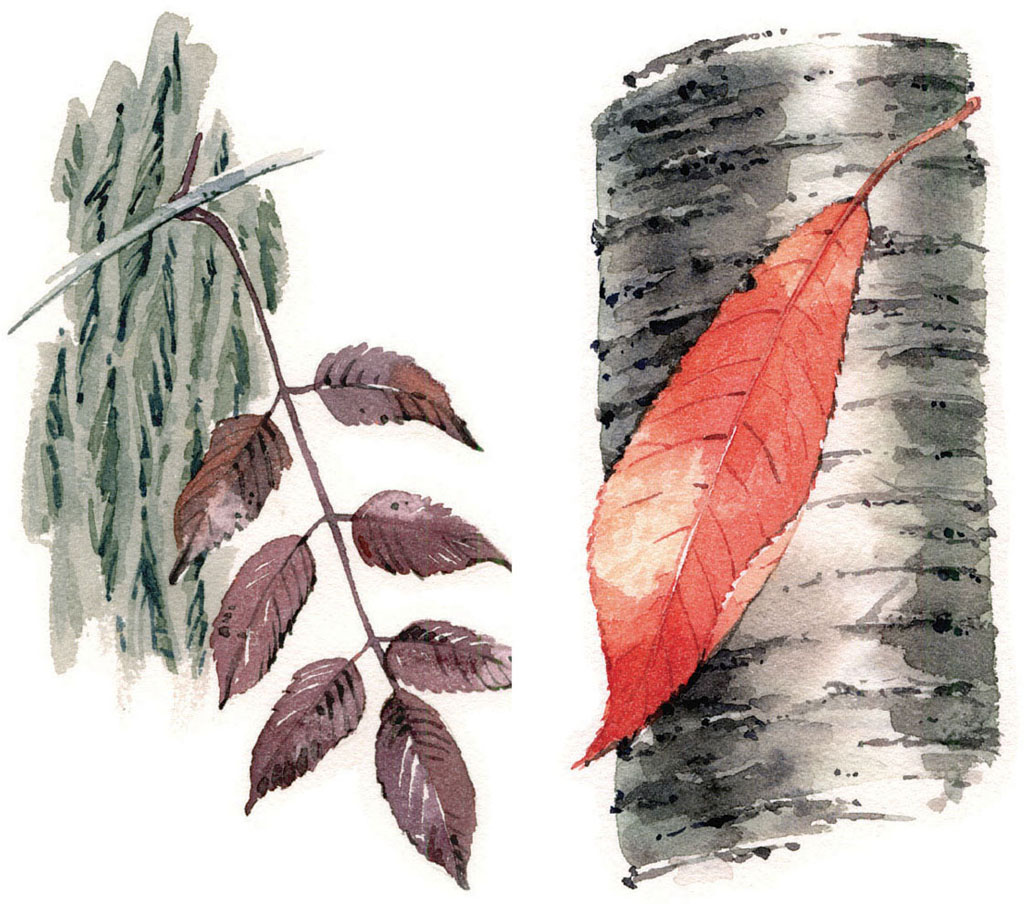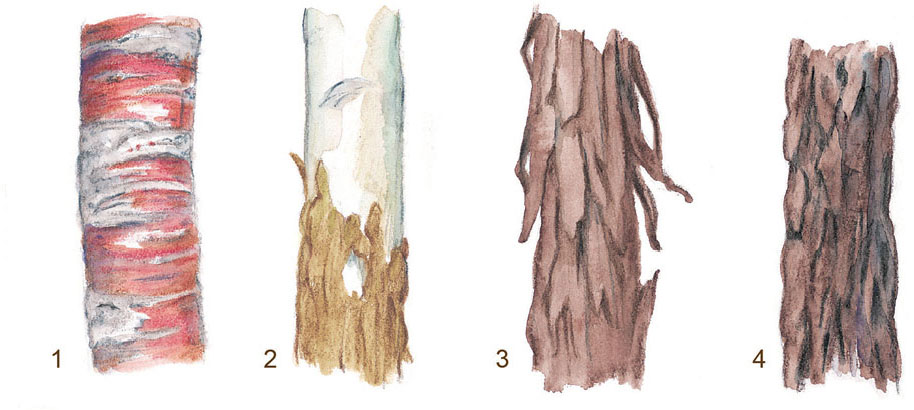
If a tree is the main subject of your painting, the leaves and bark will be an important part of your work. These elements are as varied as the species of tree.
There are many different kinds, shapes and configurations of leaves, from the simple canoe shape of the elm’s leaves to the mulberry’s mitten-shaped leaves to the fern-like leaves of walnuts and ash.

Take a look at how different these bark patterns are. If you wanted to draw a specific tree with its growing pattern and shape, it would be best to at least suggest something of its bark. Above, you can see how different a box elder is (left) from a silver maple (right).
The bark of younger trees is generally smoother than that of older trees. That’s because part of what makes the distinctive ridges and plates is the growth of the tree itself.

Some trees have deep, rugged grooves in their bark. Some trees have long, relatively thin peeling bark (that’s why they call it “shagbark” hickory). Some have shiny bark that looks as though it were stretched over the tree. Some trees have bark that is dark and gray. Others, like sycamore and paper birch, are almost pure white in places. Because these trees grow in different habitats, painting them correctly will give your work a real sense of place. Here you can see the bark and leaves of the walnut (far left) and wild cherry (left).

You can simplify painting tree bark to an easy three-step progression. First, lay down a variegated wash, keeping it cooler on the shadowed side. Let that dry, and then add sharp details of shadows and crevices. Allow that to dry, and add warm and cool shadows (these will help integrate the crisp lines you’ve laid down in step 2). This illustration is of the peeling bark of the maple tree in my backyard.
Unless you are painting a landscape on a grand scale, you will want to be aware of the differences in tree bark. They’re not all chocolate brown and they certainly are not all the same texture. Even trees in the middle distance will show some variation in color or texture, but if you are doing a close-up, depicting the type of bark takes on almost as much importance as catching a likeness in a portrait. After all, if you painted a sycamore tree (which should be a pale greenish white on the upper branches) in the manner of an oak (with deeply ridged gray bark), the sycamore would never look believable. In a landscape, the variation in hue and texture can give your painting both depth and a sense of reality. After all, isn’t that what landscapes are all about?
Bark is one means for identifying trees in the forest. There are tree identification guides that allow you to tell what tree you are looking at, even in winter, by just such details as bark. Though most types of bark aren’t as different as the ones I’ve illustrated here, you can at least learn to tell which family the tree is in—if not the exact species—through studying the bark. By learning the different types, you can give your landscapes a sense of place and reality.

Wild cherry bark is not always this colorful, but there are varieties that certainly come close. The reddish areas are smooth and glossy, and the rougher bits that girdle the tree are whitish tan or light gray. Imagine how such warmly colored bark would attract attention in a landscape. Use it judiciously, and let it be the center of interest.
Sycamores shed their thin, cardboardlike bark on their upper limbs and trunks, but the lower parts are still clothed in warm brown. To achieve this look, I used a light cool blue and a warm brown ochre to lay in the subtly varied bark on the upper part of the trunk.
Hickory bark pulls loose in interesting ways. One variety is actually called shagbark hickory. I think you can see why.
Walnut trees have deeply grooved bark that tends to form diamond shapes as the tree matures. Walnut trees have a somewhat warmer colored bark than many other varieties of trees do.